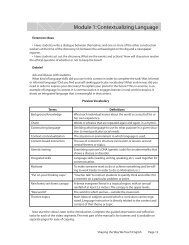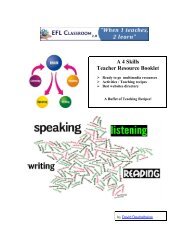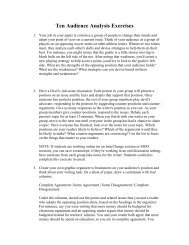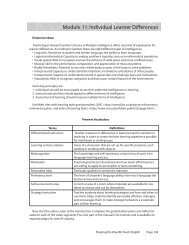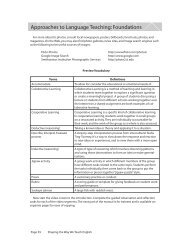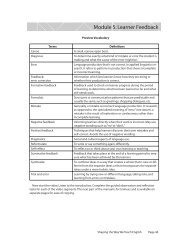Module 7: Learning Strategies - EFL Classroom 2.0
Module 7: Learning Strategies - EFL Classroom 2.0
Module 7: Learning Strategies - EFL Classroom 2.0
Create successful ePaper yourself
Turn your PDF publications into a flip-book with our unique Google optimized e-Paper software.
Approaches to Language Teaching: Extension<br />
learners. Based on the needs, resources, and time available to an institution, the next step is to plan<br />
the instruction students will receive. The following seven steps are based largely on suggestions of<br />
strategy training by Oxford (1990). The model is especially useful because it can be adapted to the<br />
needs of various groups of learners, the resources available, and the length of the strategy training.<br />
See Cohen (1998) for a thorough description of these steps.<br />
1. Determine learners’ needs and the resources available for training.<br />
2. Select the strategies to be taught.<br />
3. Consider the benefits of integrated strategy training.<br />
4. Consider motivational issues.<br />
5. Prepare the materials and activities.<br />
6. Conduct explicit strategy training.<br />
7. Evaluate and revise the strategy training.<br />
Conclusion<br />
The guidelines for implementing strategy training programs provide a variety of options for<br />
tailoring the training to meet the needs of a large number of students, as well as to the needs of the<br />
individual institution or language program. The most important considerations in the design of a<br />
strategy training program are the students’ needs, the available resources ( e.g., time, money, materials,<br />
availability of teacher trainers), and the feasibility of providing this kind of instruction.<br />
When including strategies-based instruction in a foreign language curriculum, it is important to<br />
choose an instructional model that introduces the strategies to the students and raises awareness of<br />
their learning preferences; teaches them to identify, practice, evaluate, and transfer strategies to new<br />
learning situations; and promotes learner autonomy to enable students to continue their learning<br />
after they leave the language classroom.<br />
Note<br />
The information in this digest was drawn from chapter 4 of Cohen (1998).<br />
References<br />
Chamot, A. U., & O’Malley, J. M. (1994). The CALLA handbook: Implementing the cognitive academic<br />
language learning approach. Reading, MA: Addison-Wesley.<br />
Cohen, A. D. (1998). <strong>Strategies</strong> in learning and using a second language. New York: Longman.<br />
Holec, H. (1988). Autonomy and self-directed learning: Present fields of application. Project no. 12:<br />
<strong>Learning</strong> and teaching modern languages for communication. Strasbourg, France: Council for<br />
Cultural Co-operation.<br />
Oxford, R. (1990). Language learning strategies: What every teacher should know. New York: Newbury/<br />
Harper Collins.<br />
Oxford, R. L., Crookall, D., Cohen, A., Lavine, R., Nyikos, M., & Sutter, W. (1990). Strategy training for language<br />
learners: Six situational case studies and a training model. Foreign Language Annals, 22(3),<br />
197-216.<br />
Page 114<br />
Shaping the Way We Teach English



